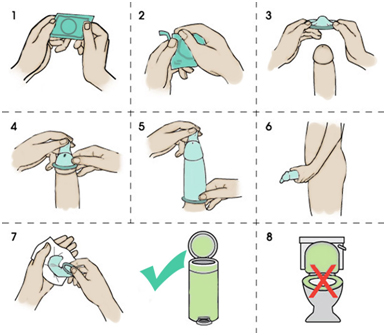Condom as a sort of protection has been one of the most successful birth control methods till date. There have been a lot of birth control methods like oral pills and vaginal dams but condoms have proven to be most popular of them. They are successful because of ease of purchase as well as usage. They also come in a lot of types and customisations.
Many of these condoms come in flavoured types for oral usage as well as textures for added pleasure. However there are a bit hiccups while using these for the first time. While using condoms prevents not only pregnancy but also sexually transmitted diseases, many times due to wrong or misfit, these tend to decrease the pleasure as well as can potentially increase the risk of pregnancy.
Using condoms in a correct manner is very important. There are times when while using condoms users tend to lose erection due to which there are fit issues. So now we will see proper methods of how to put on a condom:
- Checking for its expiry is very important. Condoms are successful because of their high elasticity and non-punctured skin. A condom which has exceeded its expiry has a fair chance of being torn while being used, thus might result in transmission of STD. Also see that it is properly packed and you are not getting something recycled from a medical store.
- Open the packet. Make sure that you open it by hands and not by teeth sine potentially it can puncture it and eliminate protection.
- Now hold the condom from its protruding tip and roll it on to the erect penis up to the base. Holding it the right way is important so that no air is left inside. Also, make sure that you roll it on the correct side. If you accidently try rolling it inside out, do not use it since there might be any sort of sexual fluids on it by that. Use another one and do it again.
- After it is on the penis, use any lube, basically if it is water based. This will reduce the friction as well as eliminate any chances of condom breakage. It will also increase the pleasure by many folds.
- After a successful intercourse and ejaculation, you should pull out while penis is erect while holding it from the base of condom so that there is no spillage inside and eliminating the risk.
- Before throwing it, tie a knot on the opening end, use a polybag and throw it in the dustbin. If any sex toys such as a dildo are being used, using a condom on them is also a good option since shared usage can lead to STDs.
After learning how to put on a condom, we must understand what kind of condom is suitable for us. Condoms come in various sizes and we must always choose the most apt size for us otherwise there might be lumps or may be it might fall short. They also come in various textures including latex and lubricated. To choose the best for yourself, it is important that one must try different types of condoms before choosing any.
Removing air and choosing the correct size in first time is very important because if these issues are there, there might be a chance of spillage and condom breaking. Condoms are important because not only they prevent pregnancy, but the barrier also prevents STDs like HIV and also oral diseases from sexual activities.
Condoms are available at even most remote of the places and are encouraged to be used. Practicing safe sex is always the best because you don’t want to live with STDs, which are like time bomb telling you that one day they will burst and take your life along.
Using a condom correctly is crucial for ensuring its effectiveness in preventing sexually transmitted infections (STIs) and unintended pregnancies. Many people may not realize that improper use can significantly reduce the effectiveness of a condom. This guide will walk you through each step of the process to ensure you are using condoms properly.

Check the Expiry Date and Packaging
Before you even open the condom package, it’s important to check the expiry date. Condoms, like many other products, have a shelf life, and using an expired condom can increase the risk of it breaking. The expiry date is typically printed on the side of the condom wrapper or box. Next, inspect the packaging for any signs of damage. The package should be intact with no tears or holes. A damaged package could mean that the condom itself might be compromised. If the package is damaged or the condom is expired, discard it and use a new one.
Open the Condom Package Carefully
When you are ready to use the condom, open the package carefully. Avoid using sharp objects like scissors or teeth to tear the package open, as this can accidentally puncture or tear the condom. Instead, use your fingers to gently tear along the edge of the wrapper. Handle the condom with care to avoid any damage. The condom should come out of the package easily and without any signs of tears or holes.
Check the Condom Orientation
Before applying the condom, ensure that you are holding it in the correct orientation. The condom should be rolled up in a ring shape. If the condom is inside out, it will be difficult to unroll and may break when you try to use it. To check the orientation, place the condom over the tip of the erect penis and gently try to unroll it. If it does not roll down easily, it is likely facing the wrong way. In such a case, discard the condom and use a new one, as trying to reposition it may damage it.
Pinch the Tip of the Condom
To properly apply the condom, start by pinching the tip of the condom. This small pinch creates a reservoir at the tip of the condom, which is essential for collecting semen and preventing it from coming into contact with your partner’s genital area. This space is also important to reduce the risk of the condom breaking. Hold the tip of the condom firmly between your thumb and forefinger to maintain this space throughout the application process.
Roll the Condom Down
Once you have pinched the tip, place the condom over the tip of the erect penis. Gently roll the condom down the length of the penis to the base. Make sure the condom rolls down smoothly and evenly, without any twists or bunching. The condom should cover the entire length of the penis to ensure full protection. If the condom feels tight or difficult to roll down, it may be too small, and you should use a larger size.
Smooth Out Air Bubbles
After rolling the condom down, check for any air bubbles trapped under the condom. Air bubbles can increase the risk of the condom breaking during intercourse. If you notice any bubbles, gently press them out by squeezing the sides of the condom. Ensure that the condom is in full contact with the skin and that there are no air pockets.
During and After Intercourse
During intercourse, regularly check to ensure that the condom remains in place. If it slips off or feels like it might break, stop and replace it with a new condom. After ejaculation, withdraw carefully while the penis is still erect to prevent the condom from slipping off. Hold the base of the condom to avoid any spillage and remove it slowly.
Remove and Dispose of the Condom
Once you have withdrawn, remove the condom by holding the base and carefully pulling it away from the penis. Be cautious to avoid spilling any semen. Wrap the used condom in tissue or toilet paper and dispose of it in the trash. Do not flush condoms down the toilet, as they can cause blockages in plumbing systems. Proper disposal helps maintain hygiene and prevents environmental contamination.
Wash Your Hands
After disposing of the condom, wash your hands thoroughly with soap and water. This helps to remove any residues and ensures personal hygiene. Cleaning up after sex is an important part of maintaining overall sexual health.
Additional Tips for Condom Use
To maximize the effectiveness of condoms, it is important to use them correctly and consistently. Here are some additional tips:
- Use One Condom at a Time: Avoid using more than one condom at a time, as this can cause friction and increase the risk of breakage.
- Store Condoms Properly: Keep condoms in a cool, dry place away from direct sunlight and heat. Avoid storing them in wallets or pockets, as friction and heat can damage the condom.
- Use Lubrication Wisely: If additional lubrication is needed, use water-based or silicone-based lubricants. Avoid oil-based lubricants, which can weaken latex condoms and increase the risk of breakage.
By following these steps and tips, you can ensure that you are using condoms effectively, reducing the risk of STIs and unintended pregnancies. Proper condom use is a key component of responsible sexual health and protection.
FAQ on Condoms
1. What is a condom and how does it work?
- Answer: A condom is a barrier method of contraception designed to prevent pregnancy and protect against sexually transmitted infections (STIs). It works by covering the penis during intercourse, preventing semen from entering the vagina and reducing the risk of STIs by creating a physical barrier.
2. What types of condoms are available?
- Answer: There are several types of condoms available, including:
- Latex Condoms: Made from rubber latex and the most common type.
- Non-Latex Condoms: Made from materials like polyurethane or polyisoprene, suitable for those with latex allergies.
- Lubricated Condoms: Pre-lubricated to reduce friction and enhance comfort.
- Textured Condoms: Have added textures like ribs or bumps for increased stimulation.
- Flavored Condoms: Designed for oral sex with various flavors.
- Ultra-Thin Condoms: Designed to increase sensitivity.
3. How do I choose the right condom for me?
- Answer: Choosing the right condom involves considering factors like material, size, and lubrication. Latex condoms are suitable for most people, but if you have a latex allergy, opt for non-latex options. Ensure you select a size that fits comfortably and consider your preferences for lubrication and texture.
4. How do I properly store condoms?
- Answer: Store condoms in a cool, dry place away from direct sunlight and heat. Avoid keeping them in places where they might be exposed to friction or pressure, such as in a wallet or car. Proper storage helps maintain the condom’s effectiveness and prevents damage.
5. Can condoms be reused?
- Answer: No, condoms are designed for single-use only. Reusing a condom can compromise its effectiveness and increase the risk of STI transmission and unintended pregnancy. Always use a new condom for each sexual encounter.
6. How can I tell if a condom is expired?
- Answer: Check the expiry date printed on the condom’s packaging. Expired condoms may be less effective and more prone to breaking. If the condom is past its expiry date, discard it and use a new one.
7. What should I do if a condom breaks during sex?
- Answer: If a condom breaks, stop intercourse immediately and withdraw. Check for any remaining pieces of the condom, and consider using emergency contraception if pregnancy is a concern. Consult a healthcare professional for STI testing and advice on next steps.
8. Are there any side effects of using condoms?
- Answer: Most people do not experience side effects from using condoms. However, some may have allergic reactions to latex or experience irritation from lubricants. If you experience discomfort or irritation, try non-latex condoms or lubricants designed for sensitive skin.
9. Can I use condoms with other forms of contraception?
- Answer: Yes, condoms can and should be used in conjunction with other forms of contraception for added protection. Combining methods, such as using condoms with birth control pills, increases effectiveness in preventing pregnancy and STIs.
10. How effective are condoms in preventing STIs and pregnancy?
- Answer: Condoms are about 98% effective at preventing pregnancy when used correctly. They are also highly effective at reducing the risk of most STIs, including HIV, though no method is 100% foolproof. Proper use is crucial for maximizing their effectiveness.
11. Can I use oil-based lubricants with latex condoms?
- Answer: No, oil-based lubricants should not be used with latex condoms as they can weaken the latex and increase the risk of breakage. Opt for water-based or silicone-based lubricants, which are safe to use with latex condoms.
12. How can I ensure I am using a condom correctly?
- Answer: To use a condom correctly:
- Check the expiry date and packaging.
- Open the package carefully.
- Check the condom orientation and pinch the tip before rolling it down.
- Roll the condom down to the base of the erect penis.
- Smooth out any air bubbles.
- Remove and dispose of the condom properly after use.
- Wash your hands thoroughly.
13. What should I do if I have questions about condom use or experience problems?
- Answer: If you have questions or encounter problems with condom use, consult a healthcare professional or a sexual health clinic. They can provide guidance on proper use, address concerns, and offer support regarding sexual health and contraception.
By addressing these common questions, individuals can better understand how to use condoms effectively and ensure they are protected during sexual activity.



